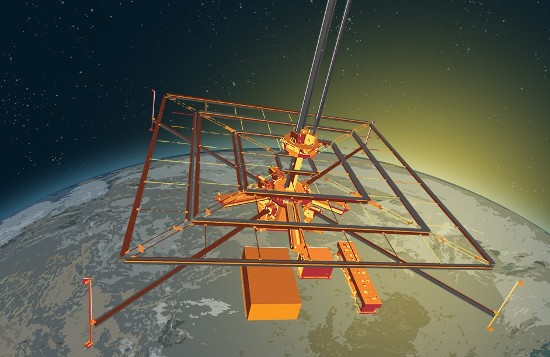A Caltech-designed prototype satellite containing an experiment, the Space Solar Power Demonstrator (SSPD), was launched on January 3rd of this year in what could prove to be a breakthrough for harvesting the energy of the Sun from space. The satellite goes by the name Momentus Vigoride and hitched its ride into space on a SpaceX Falcon 9 rocket.
Solar energy from space has been the dream of science fiction writers beginning with Isaac Asimov back in 1941 in a short story called Reason which later was included in a collection that Asimov published in 1950 entitled I, Robot. In the story, Asimov described a space station that collected energy from the Sun and transmitted it by microwave beam to various locations. Asimov recognized the distinct advantage of building solar power generating stations in space out of the Earth’s shadow and therefore continuously being able to harvest the energy of the Sun.
When the first telecommunication satellites were launched into geosynchronous orbits around Earth, it became obvious that not just communications could be offered in a continuous stream using satellite technology. A photovoltaic array parked in a similar orbit would stream electrical energy to Earth ground receivers. And depending on the size of an array deployed at that altitude, a satellite or a few of them to ensure no single failure, could become an endless supplier of all the energy the planet would need. There were technical problems still to work out.
For example, how could a large array be deployed in space? Currently, the International Space Station’s (ISS) latest upgrade of its solar panels demonstrates such a technology. Called the Roll-Out Solar Array (ROSA) its deployment makes it possible to send large arrays to space in small form factors that can physically roll out to extended lengths. Although deployed on the ISS, the potential for this technology to be used in building large solar-power stations in space is considerable.
The second big challenge is how to get the energy collected down to Earth receiving stations. The SSPD prototype includes three component systems that address these two challenges.
- The Deployable on-Orbit ultraLight Composite Experiment (DOLCE) is a new solar array architecture composed of ultrathin modules that can be expanded to create a kilometre-scale array.
- A collection of 32 different types of photovoltaic cells which has been given the name ALBA will assess which of these can work best in the harsh environment of space.
- The Microwave Array for Power-transfer Low-orbit Experiment (MAPLE) is an array of lightweight microwave power antennas designed to focus on two receivers down on Earth to demonstrate the capacity to transmit power to multiple targets on demand.
An onboard computer system interfaces with all of the components.
How Directional Wireless Power Transmission Works
The SSPD array of multiple antennae is designed to transmit power phased simultaneously and timed precisely as a highly directed energy beam focused on Earth-based receivers. In SSPD the conversion is to microwaves which are received on the ground and then converted back to electricity.
Caltech isn’t alone in exploring solar power transmission to Earth. Northrop-Grumman is working with a technology it calls SSPIDR in partnership with the U.S. Air Force Research Laboratory (AFRL). The European Space Agency (ESA) has its Advanced Concepts Team (ACT) working on a similar project. And China, last June, announced its plans by 2028 to put a demonstration satellite in low-Earth orbit (400 kilometres in altitude) to test converting 10 Kilowatts of generated solar energy to microwaves or lasers and transmitting a directed beam to multiple targets on the surface.
When will we know the Caltech technology works? Sergio Pellegrino, a Professor of Aerospace and Professor of Civil Engineering at Caltech, in a January 2, 2023 press release states “We should know right away if DOLCE works.” Which photovoltaics prove to be the best will take about six months of tests.
MAPLE is another story. Ali Hajimiri, a Caltech Professor of Electrical and Medical Engineering, is also quoted in the press release talking about the building of this component in the prototype. He states, “The entire flexible MAPLE array, as well as its core wireless power transfer electronic chips and transmitting elements, have been designed from scratch. This wasn’t made from items you can buy because they didn’t even exist.” It will take several months to verify MAPLE is performing to specification.
Could all of Earth’s electricity needs be supplied from space-based solar power stations? The American Society of Mechanical Engineers (ASME) says space-based solar panels can generate 2,000 Gigawatts of power constantly, or 40 times more energy than solar panels on the Earth. The technical challenges include the ability to overcome launch costs to get materials into space (SpaceX is demonstrating reusability which is dramatically reducing payload costs), lightweight easily deployed solar panels (ROSA sounds like a fit), microwave-or laser transmission equipment and receiving centres on Earth to collect and distribute the energy (which Caltech in this prototype should be able to demonstrate.)
So by the summer of this year, Caltech’s design team should know if they have a working prototype for solar power stations in space. The implications for the planet and its energy future are enormous. We could see a significant space-based energy industry in place by the mid-2030s. The fossil fuel industry and utility companies may want to pay close attention to what Caltech is doing.

















[…] photo: caltech […]
[…] January of this year, I wrote about Caltech’s Space Solar Power Demonstrator (SSPD) Project and the successful launch of a satellite called Momentus Vigoride with an onboard microwave […]
[…] could either feed into future grids or bypass them entirely in a fully distributed model should the current work being done at Caltech […]